(METH)allylsilane compound, silane coupling agent therefor, and functional material using same
a technology of silane coupling agent and allylsilane, which is applied in the field of meth allylsilane compound and silane coupling agent therefor, and the use of the same, can solve the problems of difficult purification, difficult to cause sol-gel reaction, and desired silane coupling reaction with the other functional groups, etc., to achieve convenient preparation, high purity, and convenient hydrophilicity.
- Summary
- Abstract
- Description
- Claims
- Application Information
AI Technical Summary
Benefits of technology
Problems solved by technology
Method used
Image
Examples
example 1
[0060](1.1) Cyclopentyl methyl ether (CPME) (90 ml) was added to 1,4-dibromobenzene (1) (15 g, 15.9 mmol) under a nitrogen atmosphere, the mixture was cooled to around −10° C. with brine ice, a solution of 2 M isopropylmagnesium chloride in tetrahydrofuran (THF) (1PrMgCl solution) (0.35 equivalent amount, 11.2 ml) and a solution of 1.67 M n-butyllithium in hexane (nBuLi solution) (0.7 equivalent amount, 26.8 ml) were respectively added dropwise. The mixture was stirred at around −10° C. for 2 hours, allyl bromide (1.1 equivalent amount, 6.8 ml) was then added, and the mixture was stirred at room temperature for 14 hours. Diethyl ether was added to the reaction mixture, and the mixture was neutralized with a saturated aqueous solution of ammonium chloride. The aqueous layer was extracted with diethyl ether, and the combined organic layer was washed with saturated brine, dried over anhydrous magnesium sulfate, filtered, and concentrated under a reduced pressure to give a crude product...
example 2
[0089](2.1) NaH (1.2 equivalent amount, 157 mg, 3.92 mmol) was washed three times with hexane under a nitrogen atmosphere, tetrabutylammonium iodide (TBAI) (120 mg, 10 mol %) and 1,2:5,6-di-O-isopropylidene-α-D-glucofuranose (10) (1 equivalent amount, 850 mg, 3.27 mmol) dissolved in 20 ml of THF were added thereto, the mixture was stirred for 30 minutes, 4-{3-(triallylsilyl)propyl}benzyl bromide (6) (1.2 equivalent amount, 1.42 g, 3.92 mmol) was then added, and the mixture was stirred for 15 hours. Thereafter methanol was added thereto, and the mixture was stirred for 30 minutes and slowly poured to ice / diethyl ether. The reaction mixture was neutralized by adding 1N diluted hydrochloric acid, and an aqueous solution of saturated sodium hydrogen carbonate was added. The aqueous layer was extracted with diethyl ether, and the combined organic layer was washed with saturated brine, dried over anhydrous sodium sulfate, filtered, and concentrated under a reduced pressure to give a crude...
example 3
[0099](3.1) 3-Bromopropyltrichlorosilane (12) (1 equivalent amount, 5 g, 19.5 mmol) was cooled to 0° C. under a nitrogen atmosphere, a solution of 1 M allylmagnesium bromide (3.3 equivalent amount, 64.5 ml) was added thereto, and the mixture was stirred at room temperature for 3 hours. Diethyl ether was added to the reaction mixture, and the mixture was neutralized with an aqueous solution of citric acid. The aqueous layer was extracted with diethyl ether, and the combined organic layer was washed with saturated brine, dried over anhydrous magnesium sulfate, filtered, and concentrated under a reduced pressure to give a crude product. The crude product was purified by separation by silica gel column chromatography (elution solvent: n-hexane) to give 3-bromopropyltriallylsilane (13) (yield amount: 5.2 g, yield: 98%).
[0100]The result of the physical and chemical analysis of this by 1H NMR is shown below.
[0101]1H NMR (CDCl3) δ=5.73-5.81 (m, 3H), 4.88-4.93 (m, 6H), 3.37 (t, J=7.2 Hz, 2H)...
PUM
| Property | Measurement | Unit |
|---|---|---|
| hydrophilicity | aaaaa | aaaaa |
| hydrophobicity | aaaaa | aaaaa |
| refractive index | aaaaa | aaaaa |
Abstract
Description
Claims
Application Information
 Login to View More
Login to View More - R&D
- Intellectual Property
- Life Sciences
- Materials
- Tech Scout
- Unparalleled Data Quality
- Higher Quality Content
- 60% Fewer Hallucinations
Browse by: Latest US Patents, China's latest patents, Technical Efficacy Thesaurus, Application Domain, Technology Topic, Popular Technical Reports.
© 2025 PatSnap. All rights reserved.Legal|Privacy policy|Modern Slavery Act Transparency Statement|Sitemap|About US| Contact US: help@patsnap.com



